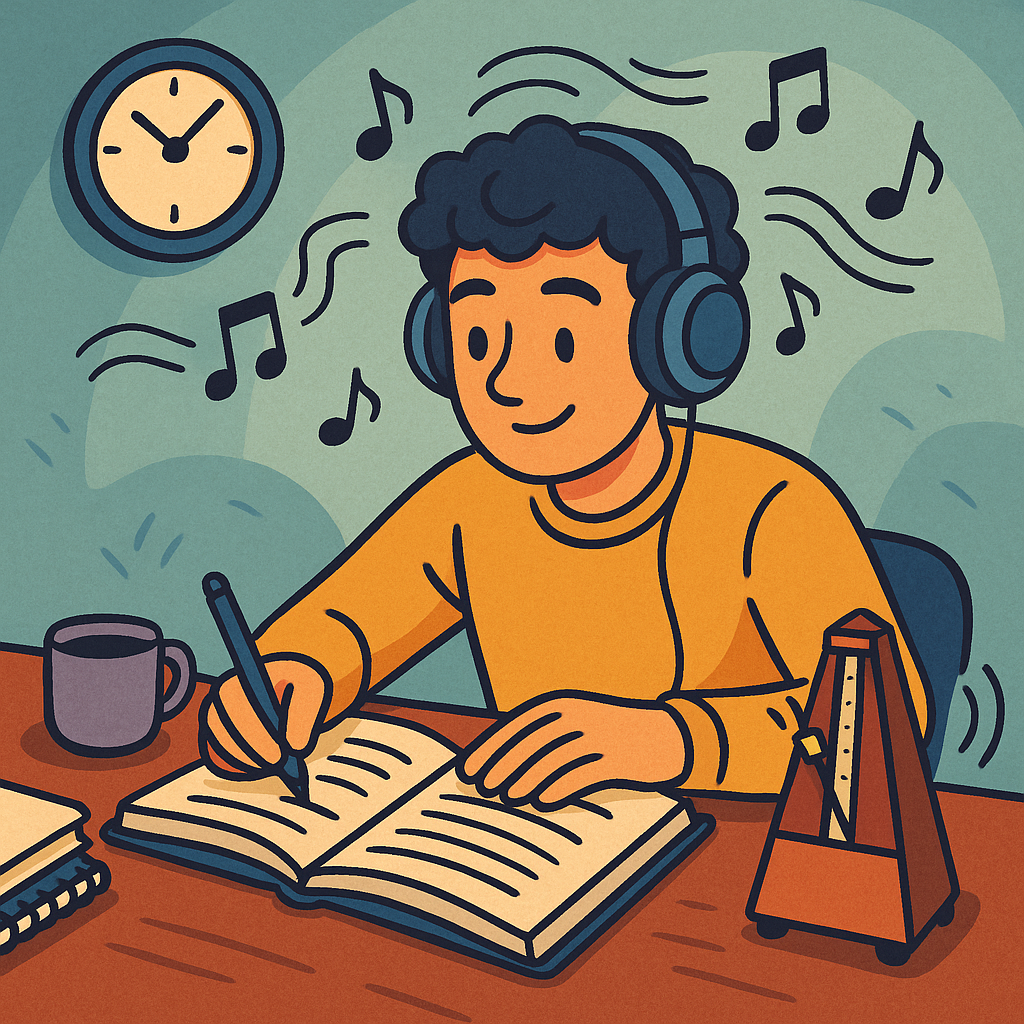Deep focus thrives on rhythm. Syncing work to natural beat patterns—whether internal brainwaves or external music—can enhance concentration and mental clarity. In this guide, you’ll learn how rhythm fuels deep cognitive work, based on the latest science, with practical steps to implement today.

1. What Is “Deep Cognitive Work”?
Deep cognitive work refers to intensive tasks requiring sustained attention, complex problem solving, and minimal distractions—such as coding, writing, strategizing, or data analysis. Unlike shallow work (emails, quick tasks), deep work demands high mental energy and sustained neural coordination.
2. How Rhythm Influences Focus
2.1. Brainwave Entrainment and Rhythmic Synchrony
Scientific studies show external rhythms—musical beats, binaural tones—can synchronize brainwaves in a process called neural entrainment.
Recent research indicates specific rhythmic patterns activate neural oscillations that prime working memory and attention networks .
2.2. Ultradian and Circasemidian Rhythms
Humans naturally cycle through ~90–120-minute ultradian rhythms of alertness and fatigue. Syncing beats or work intervals to these cycles—about 60–90 minutes on, 10–20 minutes off—aligns with biological peaks.
3. Cutting-Edge Findings in Rhythmic Cognitive Science
3.1. “Groove” Music Enhances Performance
Recent studies found music with strong grooves—the kind that makes you nod—boosts productivity and mood more than ambient or classical tracks.
3.2. AI-Driven Personalized Entrainment
Emerging work integrates music therapy, brainwave entrainment (e.g., binaural beats at 40 Hz), and AI biofeedback to create adaptive focus sessions.
3.3. Executive Function via Rhythm Training
Research shows practicing rhythm reproduction (tapping, timing exercises) enhances executive functions like memory, planning, and cognitive flexibility .
4. Practical Guide: Applying Rhythm to Your Deep Work
1: Define Your Deep Work Block
- Choose a task and aim for 60–90 minutes.
- Label it your focused “deep work” session.
2: Pick the Right Rhythm
- Groove music: ~120–140 BPM instrumental tracks—tested to enhance focus by ~20% .
- Brainwave entrainment: Apps or audio with binaural beats at 40 Hz can support memory recall and attention .
3: Structure Ultradian Cycles
- Set timer for 60–90 mins: deep work.
- Break for 10–20 mins: stretch, walk, meditate.
- Repeat 2–3 cycles per session.
4: Add Rhythm-Based Warm-Ups
- Spend 2–3 minutes tapping to a metronome or rhythm app to prime your neural networks.
5: Use Adaptive Feedback Tools
- Optionally, use AI-enabled tools that adjust tempos and rhythms based on physiological data.
5. Benefits of Rhythm-Aligned Deep Work
- Higher Focus – Brain synchrony boosts mental clarity and task engagement.
- Improved Memory – Rhythm enhances working memory through neural alignment.
- Stress Reduction – Structured rhythm lowers anxiety and cognitive fatigue.
- Creative Flow – Groove tracks and rhythmic intervals unlock more fluent idea generation.
6. Common Pitfalls & Solutions
| Challenge | Strategy |
|---|---|
| Music distracts from tasks | Stick to instrumental, loopable beats. |
| Fixed rhythms feel stale | Rotate playlists or vary break lengths. |
| Schedule constraints | Shorten blocks to 45 mins if needed but maintain breaks. |
| Skeptical of brainwave techniques | Start with proven beat-based music before exploring tech-based tools. |
7. Example Focus Session
- Begin with 2 minutes of rhythm tapping at 2 Hz (~120 BPM).
- Play groove track at ~125 BPM.
- Work for 75 mins on writing code.
- Take a 15-min break: walk, hydrate.
- Repeat cycle twice more.
- Finish with reflective 5-min journaling.
8. Future Trends
- Wearables + Rhythm Apps: Sensors detect focus dips and adapt beats in real-time.
- Virtual Co-working with Live Beats: Remote teams sync work blocks via shared pulse rhythms.
- Neurofeedback Integration: Real-time EEG measures adjust tempo to maintain gamma wave activity.
Conclusion
Rhythm is more than music—it’s a tool for optimizing deep cognitive work. By aligning external beats with your brain’s internal timing, you amplify focus, memory, and creativity. With science-backed methods and emerging tech on the horizon, rhythm-driven workflow is not just trending—it’s transforming how we think and produce.
References
1. Large-scale review on rhythm and cognition
Jones, A., & Müller, V. (2022). Editorial: Rhythm in human cognition and action: Health and pathology. Frontiers in Psychology. Retrieved from https://www.frontiersin.org
2. Neuroscience exploration of rhythmic neural processes
van Ede, F., & Nobre, A. C. (2024). Brain rhythms are key to understanding cognition. Neuroscience News. Retrieved from https://neurosciencenews.com
3. Practical applications of rhythm in learning and memory
Ripollés, P., et al. (2025). Groovy music ‘boosts brainpower as well as mood’. PLOS One (as reported by The Times). Retrieved from https://www.thetimes.co.uk






